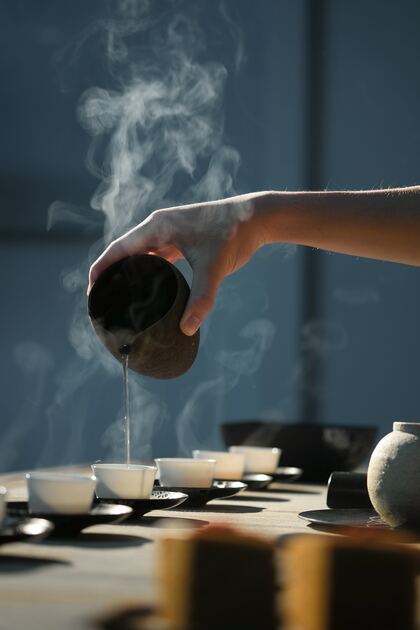The Enriching Essence of Tea Ceremonies: A Journey to Heightened Intuition
By Toni Hodge Tea Mistress

In the bustling landscape of our modern lives, where technology and rapid-paced routines often govern our actions, the art of intuition can find itself overshadowed by the clamor of the external world. Yet, within the serene ritual of a tea ceremony lies a profound opportunity for individuals to reclaim and deepen their connection with their intuitive selves. Let’s explore the ways in which participating in a tea ceremony can serve as a transformative practice, fostering mindfulness, sensory engagement, and a harmonious balance that ultimately contributes to the enhancement of intuition.
Mindful Presence: At the heart of a tea ceremony lies a deliberate and unhurried ritual that invites participants to be fully present in the moment. The deliberate, unhurried pace encourages mindful presence, allowing individuals to set aside the distractions of the external world and immerse themselves in the transformative experience of brewing and savoring tea. This heightened awareness becomes a sanctuary for the mind, creating a mental space where intuition can quietly surface amidst the noise of daily life.
Sensory Engagement: A tea ceremony engages the senses in a dance of aroma, taste, and texture. The careful preparation and appreciation of tea encourage participants to fully immerse themselves in the sensory experience. By focusing on these sensory elements, individuals not only deepen their connection with the present moment but also enhance their sensitivity to subtle cues and feelings. This heightened sensory engagement, in turn, becomes a gateway to intuitive insights that may otherwise go unnoticed.
Ritualistic Patterns: The repetitive and ritualistic nature of a tea ceremony introduces participants to the beauty of pattern recognition. As each step unfolds, from the meticulous preparation to the graceful pouring of the tea, individuals learn to recognize the rhythm and harmony inherent in the process. This practice of pattern recognition, embedded within the structure of the ceremony, extends beyond the ritual itself, empowering individuals to discern patterns in their lives and relationships, contributing to a more nuanced understanding of their intuitive faculties.
Quiet Reflection: Amidst the ritual, there are moments of quiet reflection, an intentional pause that allows participants to turn inward. This introspective aspect provides a valuable opportunity to connect with one's thoughts and feelings. Regular reflection, encouraged by the contemplative atmosphere of the ceremony, becomes a cornerstone for understanding one's own intuitive responses. It becomes a journey into the depth of one's own being, fostering a more profound connection with the intuitive self.
Harmony and Balance: Philosophically, many tea ceremonies emphasize harmony and balance. The careful consideration of each element, from the selection of utensils to the pouring of water, reflects a holistic approach. This emphasis on balance not only permeates the physical act of the ceremony but also influences the participant's mindset. A balanced mindset, cultivated within the meditative space of the ceremony, provides a fertile ground for intuitive thinking, seamlessly integrating both rational and emotional facets of decision-making.
In conclusion, participating in a tea ceremony offers more than just a delightful sensory experience; it becomes a transformative practice that cultivates mindfulness, engages the senses, recognizes patterns, encourages reflection, and fosters harmony. As individuals engage in this ceremonial journey, they rediscover the power of intuition—a quiet, yet potent force within themselves. In the midst of the ritual, intuition is not just remembered; it is rekindled, nurtured, and allowed to flourish in the sanctuary of a teacup.
Author: Toni Hodge owner of Divine Lotus Tea
3 minute read





